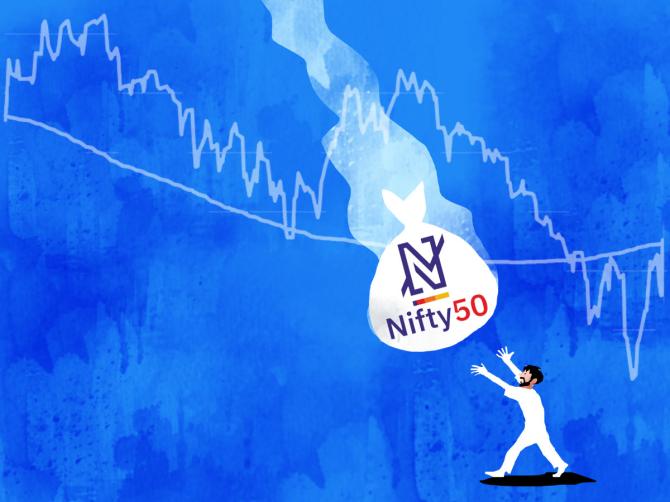Technical charts indicate a possibility of a meaningful correction in the upcoming months.

The Nifty 50 index has witnessed a solid 18.8 per cent rally so far in 2024 and the major part of the gains came in the September quarter.
The Nifty surged 14.6 per cent during the last quarter. On the longer-term scale, the Nifty 50 index has trebled, or zoomed 200 per cent, from its monthly panic close of 8,598 in March 2020.
The NSE benchmark index has ended higher in 34 of the last 54 months, showcasing clear dominance of bulls over bears.
However, going ahead, will the dominance continue in the near term or will Nifty be taking a breather?
Technical charts indicate the latter, with a possibility of a meaningful correction in the upcoming months based on the overbought conditions on one of the key momentum oscillators.
The relative strength indicator (RSI) is a key momentum indicator in determining overbought and oversold conditions of stocks and indices in the stock market.
The RSI indicator can oscillate in the range of 0 to 100. In general, an RSI reading above 70 is considered overbought, whereas a reading below 30 signals an oversold condition.
Therefore, this raises the possibility of a likely trend reversal.
Since the turn of the millennium, the RSI indicator has crossed the overbought condition on the Nifty monthly scale only on 14 counts, shows technical chart.
Invariably, the stock market (Nifty) has witnessed a price correction thereafter.
Of the 14 counts, there have been only four instances, including the present case, wherein the Nifty monthly RSI has crossed the 80-mark.
The Nifty monthly RSI as of date stands at 82.7; this momentum indicator had hit a high of 83.10 in September. The question is whether the RSI has peaked or not.

Since the start of the 21st century, the Nifty monthly RSI crossed the 80-mark for the first time ever in March 2006, and peaked at 82.80 in April 2006.
The Nifty, from a close of 3,560, went on to hit a high of 3,774 in May 2016. Then, it plunged to a low of 2,596 -- down 31.2 per cent from its May peak.

Similarly, the Nifty RSI peaked at 85.80 (the highest till date) in October 2007 with the index at 5,000 levels.
Thereafter, the Nifty registered a high of 6,357 and then crashed to a low of 2,253 -- down a massive 64.6 per cent in 10 months.
A decade ago, in November 2014, the Nifty monthly RSI peaked at 80.80 with the index value at 8,588.
The Nifty, thereafter, registered a new all-time high of 9,119 in March 2015.
Then, it slid to a low of 6,826 in February 2016 -- down 25.2 per cent.
The Nifty has indeed corrected after the RSI peaked above the 80-mark.
However, at the same time, data shows that the Nifty, in value terms, has peaked a month or so later after the RSI surged.
It seems likely that the RSI, which in general is also the lead indicator, tends to peak ahead of the actual underlying asset/ index.
In 2006 and 2014, the Nifty rallied another 6 per cent after the RSI peaked, and thereafter, the correction took place.
In 2007, the Nifty surged 27 per cent after the monthly RSI peak and then came the massive fall.
While it may be time to get cautious, there is no need to panic, suggests the historic trend, thus far.
The Nifty may even scale another 1,000 points or so before the anticipated stock market correction sets in.
The NSE Nifty 50 index, at present, is seen closing on its super trend line support at 25,650-odd levels, below which immediate support for the index is seen at 25,500 levels.
On the upside, resistance for the index is seen at 26,335 and 26,665 levels. The Nifty will need to break above 26,700 levels for fresh upside momentum.
On the flip side, break and sustained trade below 24,500 levels could weaken the existing bullish set up, suggests the medium-term chart.
Disclaimer: This article is meant for information purposes only. This article and information do not constitute a distribution, an endorsement, an investment advice, an offer to buy or sell or the solicitation of an offer to buy or sell any securities/schemes or any other financial products/investment products mentioned in this article to influence the opinion or behaviour of the investors/recipients.
Any use of the information/any investment and investment related decisions of the investors/recipients are at their sole discretion and risk. Any advice herein is made on a general basis and does not take into account the specific investment objectives of the specific person or group of persons. Opinions expressed herein are subject to change without notice.
Feature Presentation: Aslam Hunani/Rediff.com












 © 2025
© 2025